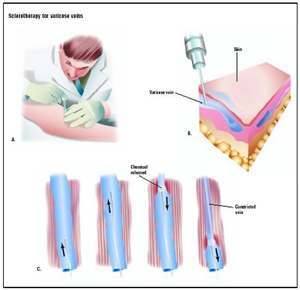Complications to Sclerotherapy as a Hemorrhoid Treatment
Sclerotherapy as a Hemorrhoid Treatment
 Sclerotherapy is a popular form of hemorrhoid treatment whereby a chemical agent is injected into the hemorrhoid to cause it to shrink and wither away. This hemroid treatment has a very high success rate at curing hemroids, however, it is not without complications, many of them due to the skill level of the doctor performing the procedure. Statistics confirm that complications occur in about 1 in every 5,000 sclerotherapy hemroid treatments, and most of these are due to improper technique used by the physician.
Sclerotherapy is a popular form of hemorrhoid treatment whereby a chemical agent is injected into the hemorrhoid to cause it to shrink and wither away. This hemroid treatment has a very high success rate at curing hemroids, however, it is not without complications, many of them due to the skill level of the doctor performing the procedure. Statistics confirm that complications occur in about 1 in every 5,000 sclerotherapy hemroid treatments, and most of these are due to improper technique used by the physician.
Complications that Can Arise from Sclerotherapy
Bleeding and pain are normal after-effects of sclerotherapy as a hemorrhoid treatment, but if you experience too much of either, it is a sign that the procedure may have been done incorrectly. Too much bleeding is an indication that the injection was made in the mucosa layer instead of just the hemorrhoidal tissue. It can also indicate that too much solution was used in the injection during hemroid treatment. Ulceration can develop in either of these scenarios, and typically the patient would still be experiencing bleeding up to 7 to 14 days after the hemorrhoid treatment occurred.
Improper selection of the site of injection is a mistake that can cause excessive pain after sclerotherapy hemorrhoid treatment. If the chemical agent used spreads beyond the hemorrhoidal tissue into other, sensitive tissues, it can cause extreme pain after the hemroid treatment. Likewise if the injection is done below the dentate line of the anal canal, pain can ensue after this hemorrhoid treatment.
Injection to the prostate gland is another possible complication of sclerotherapy as a hemroid treatment when the doctor performing the procedure is not very experienced. This results in numerous side effects, depending upon how deeply the prostate was penetrated by the needle. Some of the side effects are very minor and only temporary, while others can require hospitalization for treatment.
One of the temporary side effects of the sclerotherapy needle penetrating the prostate during hemroid treatment may be problems urinating. Again, this is usually temporary, but it may require that a catheter be inserted to relieve the pressure in the bladder and allow for urination.
If the chemical agent reaches the seminal vessel when the needles pierces the prostate, it can spread to the testicles and surrounding tissue. Infertility may result from this complication during hemorrhoid treatment.
Inflammation of the prostate glad, also called prostatitis, is another negative side effect that can arise when the prostate is pierced during sclerotherapy hemorrhoid treatment. This effect can be temporary or it can last for months or years. Prostate symptoms may include a burning sensation during urination, pain, frequent urination, blood or pus in the urine, or partial incontinence. There is not much that can be done for this particular side effect, although some men’s symptoms are improved by antibiotics.
Abscess formation can also occur when the prostate is pierced during sclerotherapy hemroid treatment. When an abscess forms, surgery is usually required to treat the condition.
Another possible complication of sclerotherapy hemroid treatment is the accidental injection of the chemical agent into the anal vein. An indicatorthat this has happened is the chemical agent will absorb abnormally rapidly during the procedure. After the procedure, the patient may notice a strange taste in his mouth, and may experience pain in the area of the liver. There are no long-term negative side effects when this complication occurs, however, the sclerotherapy as a hemorrhoid treatment will not work.
Finally, blood clotting is another complication that can occur during sclerotherapy as a hemorrhoids treatment. For that reason, second- or third-degree hemorrhoids should be treated by another hemroid treatment method.